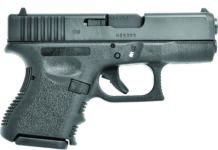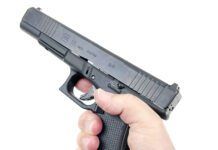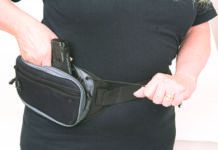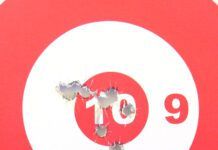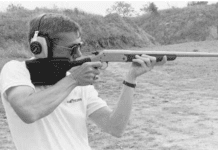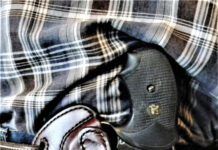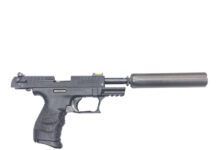Rimfire rifle ammunition was used as far back as the U.S. Civil War to launch big, big bullets. But in todays modern era, we think of much smaller rounds, with 22 Winchester Magnum Rimfire (WMR) and 17 Hornady Magnum Rimfire (HMR) topping the list in power and effectiveness. The 17 HMR was developed by necking down the case mouths of 22 WMR shells to accept more sophisticated VLD bullets that fly with less drag, producing a flatter trajectory and greater terminal performance. The purpose behind both cartridges was to provide greater versatility, range – and in our view – fun. But they are now challenged by the new 17 Winchester Super Magnum (WSM) rimfire cartridge. This new cartridge breaks many a mold because it was developed not from a traditional rtifle round but from a nail-gun cartridge commonly used in the construction industry.
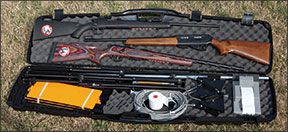
For a three-cartridge test we found two bolt guns and an autoloader to shoot side by side. We were curious to see how a magazine fed semi-auto, the $510 Model 512 22 WMR from CZ-USA, would fare in a varmint-cartridge test. Theres nothing wrong with more output if an autoloader is accurate and not too finicky. There are precious few 22 WMR autoloaders in production, due supposedly to reliability issues and, of course, demand. Our second test gun was the $527 Savage Arms 93R17 BRJ 17 HMR bolt-action rifle with spiral fluted barrel. Our third test gun was the $359 Savage Arms B.Mag bolt-action rifle chambered for the 17 WSM.
Finding 17 HMR test ammunition was no problem. Test rounds included Winchesters 20-grain Super X rounds and two choices from Hornady. These were the 15.5-grain NTX rounds and the rounds topped with V-Max bullets featuring a pointed red tip and weighing 17 grains, the traditional bullet weight for this caliber. Winchester Magnum Rimfire ammunition was scarcer, but we bought 45-grain Hornady Critical Defense, 40-grain Speer Gold Dot hollowpoints, and 40-grain Maxi-Mag TMJ rounds from CCI. Our Savage 17 WSM was limited to only one round, Winchesters Varmint HE with 25-grain polymer-tipped bullet. This posed a question outside our tests: Would we buy a rifle for which only one commercially loaded round was available?
We shot each rifle for accuracy from the 100-yard line at American Shooting Centers in Houston using a Harris BR (bench rest) bipod up front and a beanie bag from Triad Tactical beneath the stock. For optics, we stayed with the Nikon Monarch 4-16X23mm BDC scope purchased from Brownells in December 2012 and jumped it from gun to gun. By the time we completed this test, the Nikon had been mounted and readjusted more than 34 times. Heres how the rifles performed:
CZ-USA 512 No. 0216 22 WMR, $510
The CZ 512 offered a mix of old and new technology. The stock and forend were fashioned from beech without checkering, but was pleasingly finished. The buttplate was plastic, and there were sling studs fore and aft. In between was where things got interesting. The lower portion of the receiver consisted of fiberglass-reinforced polymer and contained the trigger mechanism and detachable magazine housing. The upper half of the receiver was composed of an aluminum alloy that secured the hammer-forged barrel and chromed bolt assembly.
The CZ 512 shares 5-shot single column magazines ($25) with the CZ 455 series rifles that have been available for a long time. Extra magazines (including 10-round mags, $35) are easy to find. The magazine release was on the lower receiver just forward of the magazine well. It was a small drop down lever we pulled rearward to discharge the mag. The 512 utilized a crossbolt safety located at the upper rear corner of the trigger guard, which was molded as one with the receiver. Inside the trigger guard was a small sheetmetal lever that served as the bolt stop. Without manually pulling back the right-side bolt handle and pushing the lever upward, the bolt returned to the closed position when the magazine was empty.
The CZ 512 differed from our other rifles by offering a set of open sights as well as facility for mounting a scope. There was a 11mm dovetail for mounting scope rings directly to the receiver, and CZ also offers a Weaver-style adapter plate ($46 from Shop.CZ-USA.com). Installing the Weaver mount would allow the shooter to choose from a wider variety of rings.
We chose to utilize the integral rail and mount our scope using a pair of steel-construction CZ-USA scope rings. These rings do not require a cross notch for a secure fit, so we were free to shift the scope forward or back without limitation. This proved helpful because we needed the front of the scope to clear the rear sight assembly and still provide the proper distance to the shooters eye.
At the bench, the recoil impulse of the blowback mechanism gave us a bit of a surprise compared to the bolt-action rifles. We learned that without a solid cheekweld on the comb, the shooter was in for a fair amount of slap.
The trigger on the 512 was a little heavier than we think was necessary, with no indication in the owners manual that it was user adjustable. Trigger weight registered between 5.75 pounds and 6.25 pounds of resistance with a little bit of creep. Although such characteristics are not ideal for accuracy, we did manage to produce 5-shot group averages of 1.1 inches, 1.4 inches, and 1.2 inches firing the Hornady 45-grain Critical Defense ammunition, the 40-grain Speer Gold Dots, and CCI Maxi-Mag rounds, respectively.
The front sight unit was a tall blade protected by a hood. The rear sight slid forward and back, up and down a ramp for elevation adjustment, and was secured by a locking screw. The blade was drift adjustable for windage. With the cheek hunkered down on the comb so the eyes can meet the sights, we got a tightly bonded cheekweld that removed any stock slap. If we owned this rifle and were going to shoot a scope on it full time, we would remove the rear sight so that the scope can be mounted as low as possible.
Another aspect of owning a semi-automatic rimfire rifle is keeping it clean. We did fire some lead bullets through the CZ 512 (Winchesters 45-grain Dynapoint Magnum), but shooting primarily jacketed bullets all but eliminated the need to take down and clean the action. We found that brushing the bolt face and the breech was enough to keep things running, but heres how the CZ 512 takes down for cleaning. Remove the magazine, lock back the bolt and inspect the chamber. Release the bolt. Loosen the screw in the forestock and pull it toward the muzzle to remove. Depress the barrel to release the body locking pin. Push the pin sideways (with a tool if necessary). You can now pull apart the barrel and receiver, but the bolt handle will need to be removed for complete separation. Remove the bolt handle by pulling it outward, overcoming a slight detent. Now the two parts can be separated completely, but you need to control the bolt so that the recoil spring does not eject the bolt. Hold on to the bolt top firmly, push it slightly to the rear to overcome the pressure of the recoil springs and tilt it upward to allow for complete removal. All in all, this was not daunting, but it was tricky the first time we tried it, especially when compared to servicing a bolt-action rifle.
Our Team Said: After experiencing complete reliability firing the CZ USA 512, we have to wonder why other manufacturers gave up on semi-automatic 22 WMR rifles. By using jacketed ammunition, most of the debris was blown out by ignition, so fouling was a minor issue, in our view. Accuracy was on par or better than other 22 WMR rifles previously tested (February 2009). Above all, this is a gun that is good looking, fun, acceptably powerful, highly reliable and currently, unique.
Savage Arms 93R17 BRJNo. 96770 17 HMR, $527
The model 93R17 BRJ is just one of 16 different rifles that make up the Savage Arms 17-series roster, each of which, save the B.Mag, are chambered for 17 HMR. The color of the vented wood-laminate stock was spectacular and so was the spiral fluting applied to the richly blued barrel. It measured about 0.80 inches in diameter at the muzzle.
The weight and overall size of this rifle was what wed expect from a full-size centerfire rifle. It even had dual sling studs beneath the forend. The buttstock was covered by a rubber pad that toe-to-heel measured 5 inches, providing a satisfying mount. Members of our staff said theyd welcome its raised comb and palm-filling pistol grip on any rifle they owned. The finish was smooth without being slippery, and length of pull measured 13.8 inches. At the range we reveled in the Savages big-gun handling. And underneath all that good-feeling wood was an action that was pillar bedded.
Mechanically, the bolt action was smooth and precise. The safety worked with a simple two position throw, forward and back, and it was topped with a checkered knob that really was slip-proof. The shooter released the bolt by pressing the trigger with the safety lever forward in the off position.
Both of our Savage test rifles arrived with two-piece scope mounts solidly in place. Another feature shared by the two rifles was their AccuTriggers. A video on the company website said, The AccuTrigger is the first factory trigger designed to have minimal sear engagement for a light and crisp trigger while maintaining a margin of safety. Specifically, this offered a light trigger with drop-safe capability. The key was the hinged inset housed by the trigger shoe. Called the Accurelease, it effectively blocked the sear. The Accurelease must be fully depressed for the rifle to fire. The trigger can be adjusted, but the web page warns that adjustment or modification by other than a qualified gunsmith (we read this as meaning the factory or a bonafide representative thereof) will void the warranty. In any event, the resistance presented by the trigger on our rifle felt lighter than the 3.5-pound reading on our Chatillon IN 25 trigger-pull gauge, and it was pleasingly crisp, too. Our staff felt there was nothing to be gained from further adjustment.
At the range, a problem soon developed with the 5-round single-column magazine. The rifle arrived with only one magazine, so we had to fix this one or put off testing until a fresh one could be obtained. The magazine entered the receiver along a guide – a rigid sheetmetal tab extending vertically from behind the magazine well. The rear of the magazine body provided a track so that it slipped upward along the tab as the magazine enters the receiver. The magazine release pressed against the back of the magazine and was pulled rearward to release pressure on the magazine body. The mag can then be removed. Serious difficulty began when rounds began popping out of the magazine as the bolt was pulled back.
Before we began having problems with rounds becoming unseated, we were having difficulty keeping the magazine in place. It became wobbly and didnt want to stay in the receiver. In our struggle to assure proper seating, we tried to adjust the track on the back side of the magazine. In so doing we most likely deformed the magazine body sufficiently so that the spacing between the magazine lips was widened to the point where they no longer retain ammunition. The sheetmetal magazine consisted of a basepad and vertical structure wrapping around the front in a C shape, ending in lips at the rear to grasp the guide protruding from the receiver. The rear of the magazine was sealed by a separate piece that was pegged and stamped into place. We used a pair of pliers to close the lips of the magazine sufficiently so that we could continue shooting without further incident.
The results of our accuracy tests at 100 yards showed we could average sub-MOA groups with two of our three test rounds. Hornady NTX and V-Max rounds produced a 5-shot group average of 0.90 inches across. The 20-grain Winchester Super Xs trailed with a 1.2-inch average.
Our Team Said: The Savage Arms 93R17 BRJ is one of the most appealing rimfire rifles weve tested. Its only downfall was the quality of the magazine. We were able to repair the magazine, and extras cost only a nominal $20 ($25 for stainless steel). Still, we had to downgrade what is a very good rifle because of the quality of this important part.
Savage Arms B.Mag Sporter No. 9690117 Winchester Super Magnum Rimfire $359
When we first heard about the power of the new 17 Winchester Super Magnum, we wondered which would be more remarkable, the cartridge itself or the rifle that shoots it. Winchester supposedly produces 17 WSM cartridge in three initial offerings, ranging in bullet weight/velocity from 20 grains at 3,000 fps to 25 grains rated at 2,600 fps. The only round we were able to buy was the 25-grain Varmint HE topped with a plastic-tipped bullet. Measured average velocity was 2579 fps, producing some 370 foot-pounds of muzzle energy. This was about 120 foot-pounds greater energy than the Savage 17 HMR.
The intent of this new cartridge can be garnered from text found on the Winchester.com website, which reads, The .17 Win Super Mag offers the downrange performance of a centerfire cartridge at a fraction of the cost. We paid $19.95 for a 50-round box and got 370 foot-pounds of energy, on average. How does this compare to small-caliber centerfire rounds? Our comparison shopping at Brownells.com indicated typical pricing for 25 rounds of 17 Hornet to be about $20 for about 590 foot-pounds of energy per shot. Twenty rounds of 204 Ruger ammunition cost approximately $18.50 and should provide about anywhere from 950 foot-pounds to 1200 foot-pounds. So were skeptical about Winchesters claim regarding power, but the 17 WSM is certainly head and shoulders above other rimfire cartridges and economical to boot.
Upon ordering the Savage Arms B.Mag Sporter, we first noticed its remarkably low suggested retail price. Upon its arrival, we found not a beefy target/varmint rifle but rather a petite handy rifle with synthetic stock and tang-mounted safety, flush fit 8-round rotary magazine, 3.75-pound AccuTrigger, and two-piece scope mount already in place. Also, the B.Mag rifle offered a free-floated 22-inch-long barrel and 14-inch length-of-pull stock. Overall length was 40 inches, and the B.Mags exceptional balance hid the fact that it actually weighed about 7 pounds fully loaded.
The stainless-steel bolt had a very slick finish, and when it was rotated into place, the operator was convinced by its heavy lockdown that yes, this is not a 22 LR. At the range, we noticed that the somewhat odd-looking bolt handle was best operated in a specific motion – maintaining pressure toward 11 oclock on the bolt handle both forward and back to eject the spent case and lock fresh ordnance into the chamber. Feeding from the rotary magazine proved reliable. As of this writing we couldnt find additional magazines on the manufacturers website, but we did find some listed on the Armslist.com for $50 each.
Our first range day was windy and rainy enough to discourage most shooters, but we took the opportunity to see how well 17 WSM rounds would handle crosswinds and swirling gusts. From the 100-yard line, we did manage to land a couple of groups that measured near what was achieved on a calm day. Fired under good conditions, average 5-shot groups computed to about 1.5 inches across at 100 yards. The AccuTrigger was consistent and broke cleanly.
Our Team Said: This is a well-balanced rifle with a compact feeling that put a smile on our faces. While 17 WSM wont supplant competing centerfire rounds, it offers considerably more power than other rimfire cartridges without inflating costs too much.
Written and photographed by Roger Eckstine,0.using evaluations from Gun Tests team testers. GT


